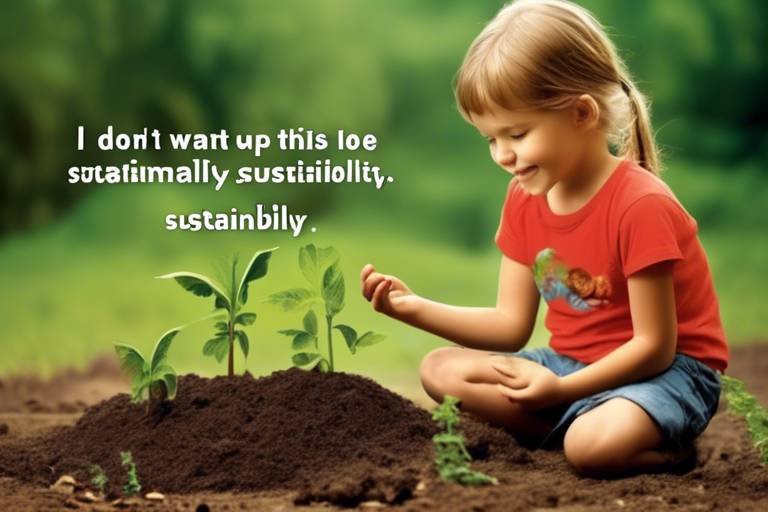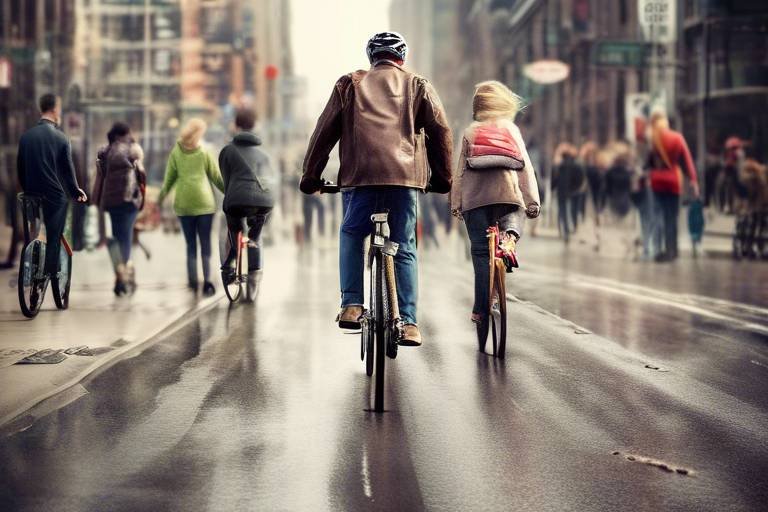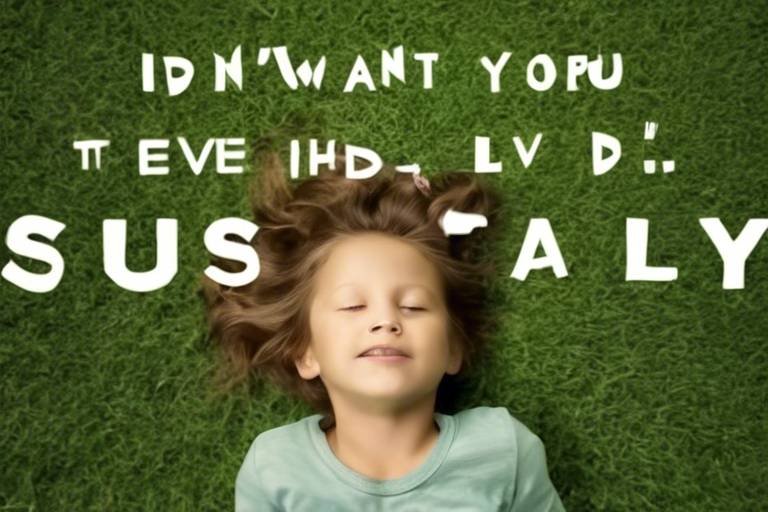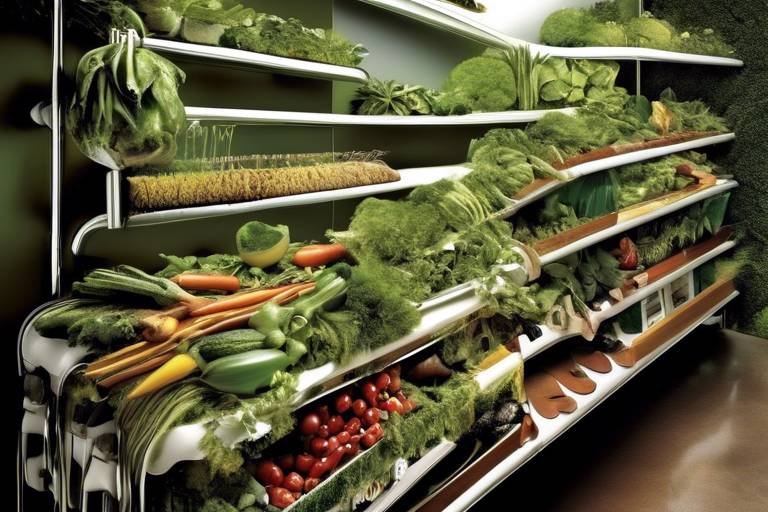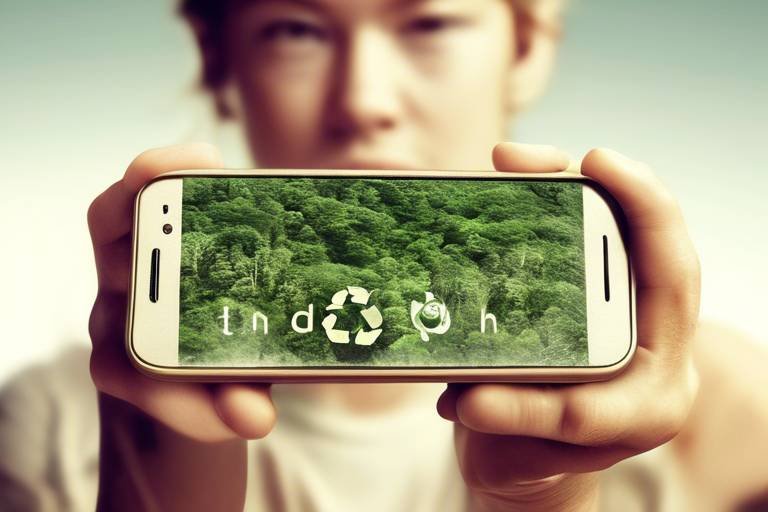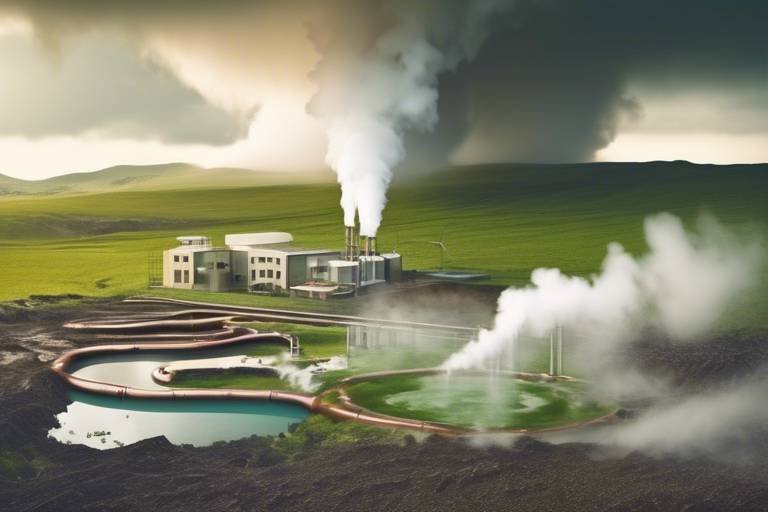How to Teach Children About Sustainability
In today's rapidly changing world, understanding sustainability is more important than ever. Teaching children about sustainability isn’t just a nice idea; it’s a crucial step towards ensuring a healthy planet for future generations. But how do we make this complex topic relatable and engaging for young minds? The answer lies in a combination of fun activities, hands-on experiences, and meaningful discussions that resonate with their everyday lives. By breaking down the concept of sustainability into digestible pieces, we can empower children to make informed choices that positively impact the environment.
Sustainability can be defined as the ability to meet our own needs without compromising the ability of future generations to meet theirs. This means using resources wisely and taking care of our planet. To help children grasp this concept, we can start by discussing the basic elements of sustainability, including environmental health, economic viability, and social equity. For instance, when children learn about how their daily choices—like using plastic straws or wasting food—affect the environment, they begin to see the bigger picture. It's like giving them a pair of eco-friendly glasses that allow them to see how every action has a ripple effect on the world around them.
Engaging children in nature-related activities is one of the most effective ways to enhance their appreciation for the environment. When kids are actively involved in exploring nature, they not only learn about sustainability but also develop a sense of wonder and curiosity. Imagine them running through a field, discovering insects, and marveling at the beauty of a blooming flower. These experiences create lasting memories that instill a deep love for the planet. Activities such as outdoor exploration, nature walks, and gardening projects can transform learning about sustainability into a fun and interactive adventure.
Taking children outdoors to explore local ecosystems fosters curiosity and a connection to nature. Whether it’s a trip to a nearby park or a hike in the woods, these adventures allow kids to witness the beauty and complexity of their environment firsthand. They can observe how different plants and animals interact, which lays the groundwork for understanding biodiversity. It's like opening a treasure chest filled with wonders just waiting to be discovered!
Organizing nature walks is a fantastic way for children to observe wildlife and plants in their natural habitats. During these walks, you can encourage them to ask questions, make observations, and even take notes about what they see. This hands-on approach deepens their understanding of biodiversity and the importance of conservation. As they learn about the various species they encounter, they begin to appreciate the delicate balance of ecosystems and the role they can play in protecting them.
Involving children in gardening is another excellent way to teach them about sustainability. When kids plant seeds, nurture them, and watch them grow, they gain firsthand experience of plant life cycles and food sources. This not only teaches them where their food comes from but also highlights the significance of growing their own food sustainably. Imagine the pride on their faces when they harvest their first tomatoes or carrots! Gardening can be a metaphor for life: nurturing something requires patience, care, and responsibility.
Utilizing books, documentaries, and online resources can provide children with valuable information about sustainability and environmental issues. There’s a wealth of engaging materials available that can spark their interest and expand their knowledge. For example, you might introduce them to documentaries that showcase the wonders of nature or books that tell stories of environmental heroes. These resources can serve as conversation starters, helping to reinforce the lessons learned during outdoor activities.
Teaching children about recycling is vital for helping them understand waste management and the importance of reusing materials. By introducing them to the concept of recycling early on, we can instill responsible habits that last a lifetime. It’s like giving them a superpower to reduce their ecological footprint! Children can learn how recycling works by participating in fun, hands-on activities that demonstrate the process in a tangible way.
Engaging children in creative recycling projects can make learning about waste reduction enjoyable while encouraging resourcefulness. For instance, turning empty cereal boxes into bird feeders or using plastic bottles to create planters can be both fun and educational. These crafts not only teach kids about recycling but also show them that discarded items can have a new life. It’s a wonderful way to blend creativity with environmental consciousness!
Involving children in local recycling initiatives fosters a sense of responsibility and community engagement. Participating in community clean-up days or recycling drives reinforces the importance of collective efforts in sustainability. When kids see the impact of their actions on their community, it empowers them to take pride in their contributions. It’s like being part of a team working towards a common goal—saving the planet!
- What age is appropriate to start teaching children about sustainability? It's never too early! Even toddlers can learn basic concepts through simple activities.
- How can I make sustainability fun for my kids? Incorporate games, crafts, and outdoor activities that engage their imagination and curiosity.
- Are there specific books or resources you recommend? Yes! Look for age-appropriate books about nature, recycling, and environmental heroes. Documentaries can also be a great visual tool.
- How can I involve my community in sustainability efforts? Organize local clean-up events, recycling drives, or educational workshops to raise awareness and encourage participation.

Understanding Sustainability
Sustainability is a term that has gained immense importance in recent years, but what does it really mean? At its core, sustainability refers to the ability to meet our present needs without compromising the ability of future generations to meet their own needs. It encompasses a variety of practices and principles aimed at preserving our planet's resources—be it air, water, or biodiversity. Teaching children about sustainability is crucial as it helps them understand their role in the world and the impact of their actions on the environment.
Imagine a world where every child grows up with a deep respect for nature and a sense of responsibility towards the planet. By instilling the values of sustainability in children, we are not just preparing them for the future; we are empowering them to be the change-makers in their communities. This understanding of sustainability can be broken down into three main pillars: environmental protection, social equity, and economic viability. Each of these components plays a vital role in creating a balanced and sustainable world.
To illustrate, consider the following table that summarizes these pillars:
| Pillar | Description |
|---|---|
| Environmental Protection | Preserving natural resources and ecosystems to maintain biodiversity. |
| Social Equity | Ensuring fair access to resources and opportunities for all individuals. |
| Economic Viability | Supporting economic systems that are sustainable and beneficial for the environment. |
By breaking down sustainability into these components, we can help children realize that it’s not just about recycling or conserving energy; it’s about creating a balanced approach to living that considers the well-being of people and the planet. When children understand that their everyday choices—like the products they buy, the food they eat, and how they dispose of waste—affect not only their immediate environment but also the world at large, they are more likely to make conscious decisions that align with sustainable practices.
Furthermore, it’s essential to relate sustainability to their daily lives. For example, discussing how the food they eat travels from farm to table can spark interest in where their food comes from and how it impacts the environment. You might ask them questions like, “Did you know that some foods require a lot of water to grow? What can we do to choose foods that are better for the environment?” These kinds of discussions can open up a dialogue about local versus global impacts and the importance of supporting sustainable practices in their community.
In conclusion, understanding sustainability is not just an academic exercise; it’s about nurturing a mindset that values the planet and all its inhabitants. By making sustainability relatable and relevant to children, we can inspire a new generation of environmentally conscious individuals who are eager to take action for a better future. So, let’s dive deeper into ways we can engage children with nature and sustainability in the following sections!

Incorporating Nature Activities
Engaging children in nature-related activities is one of the most effective ways to cultivate their appreciation for the environment. Imagine this: a child discovering the beauty of a butterfly fluttering by or the intricate patterns on a leaf. These moments can spark curiosity and a desire to learn more about the world around them. By incorporating outdoor activities into their routine, we can make learning about sustainability not just informative, but also fun and interactive. Let's explore some exciting ways to get kids involved with nature!
Taking children outdoors is like opening a treasure chest of opportunities for exploration and discovery. Local ecosystems are filled with wonders waiting to be uncovered. Whether it’s a nearby park, a nature reserve, or even your own backyard, these environments provide a rich backdrop for children to engage with nature. As they observe the different plants, animals, and insects, they develop a sense of connection and responsibility toward the earth. This hands-on experience not only fosters curiosity but also instills a deep-rooted care for their surroundings.
Organizing nature walks is a fantastic way to immerse children in the wonders of the natural world. During these walks, children can observe wildlife and plants up close, deepening their understanding of biodiversity. For instance, you can encourage them to spot various bird species or identify different types of trees. By discussing the roles these organisms play in the ecosystem, children can grasp the importance of conservation. Nature walks also provide an opportunity for children to ask questions, sparking discussions that can lead to a greater understanding of environmental issues.
Involving children in gardening projects can be a transformative experience. It’s not just about planting seeds; it’s about teaching them the entire lifecycle of plants and the significance of sustainable food sources. When children grow their own vegetables, they learn where their food comes from and the effort it takes to nurture it. This hands-on activity can lead to discussions about organic farming, the benefits of local produce, and the impact of industrial agriculture on the environment. Plus, there’s something incredibly rewarding about harvesting your own fruits and vegetables!
Utilizing various environmental education resources can significantly enhance a child's understanding of sustainability. Books, documentaries, and online platforms are treasure troves of information that can captivate young minds. For example, reading a captivating story about a young environmentalist can inspire children to take action in their own communities. Documentaries can visually showcase the beauty of our planet and the challenges it faces, making the issues more relatable. By exposing children to diverse resources, we can ignite their passion for protecting the environment.

Outdoor Exploration
Outdoor exploration is one of the most exciting and impactful ways to teach children about sustainability. Imagine stepping outside into a world filled with vibrant colors, the sound of rustling leaves, and the fresh scent of earth after rain. This is where children can truly connect with nature, fostering a sense of curiosity and responsibility towards their environment. When kids engage in outdoor activities, they not only learn about the ecosystems around them but also develop a deeper appreciation for the planet we inhabit.
One effective way to initiate outdoor exploration is by organizing nature walks. These walks provide children with the opportunity to observe wildlife and plants in their natural habitats. As they walk along trails, they can spot various species of birds, insects, and even small mammals. This hands-on experience can lead to discussions about biodiversity, the food chain, and the delicate balance of ecosystems. For instance, when children see a butterfly fluttering from flower to flower, they can learn about pollination and the role these creatures play in our food systems.
Additionally, incorporating activities like scavenger hunts can make outdoor exploration even more engaging. Children can be given a list of items to find, such as different types of leaves, rocks, or signs of animal life. This not only makes the experience fun but also encourages them to observe their surroundings closely. By identifying various elements of nature, children can learn about the importance of each component in maintaining ecological balance. For example, they might discover how fallen leaves decompose and enrich the soil, leading to discussions about nutrient cycles.
Another fantastic way to enhance outdoor exploration is through gardening projects. When children get their hands dirty in the soil, they learn about plant life cycles, the importance of local food sources, and the significance of sustainable practices. They can plant seeds, water them, and watch them grow, which teaches patience and responsibility. Moreover, gardening can spark conversations about where food comes from and the impact of industrial farming on the environment. Children can be encouraged to grow their own vegetables, which not only promotes healthy eating but also reinforces the idea of sustainability through self-sufficiency.
In summary, outdoor exploration is a vital component of teaching children about sustainability. By immersing them in nature, whether through nature walks, scavenger hunts, or gardening, we cultivate their understanding and appreciation for the environment. This hands-on approach not only makes learning enjoyable but also instills a sense of stewardship for our planet that can last a lifetime. So, why not lace up those hiking boots and venture into the great outdoors? The wonders of nature await!
- How can I encourage my child to spend more time outdoors?
Start by planning regular outdoor activities, such as hiking, picnics, or visits to local parks. Make it a family tradition to explore nature together, and consider enrolling them in outdoor clubs or programs.
- What are some simple gardening projects for kids?
Begin with easy-to-grow plants like herbs (basil, mint) or vegetables (radishes, lettuce). Kids can also create container gardens using recycled materials, which adds a fun and sustainable twist.
- How do nature walks benefit children's learning?
Nature walks enhance observational skills, promote physical activity, and provide experiential learning opportunities. They also encourage curiosity and foster a connection to the environment.

Nature Walks
Nature walks are not just a stroll through the park; they are a gateway to the wonders of the natural world. Imagine stepping outside, the sun warming your face, and the fresh air filling your lungs. For children, this experience can be magical, igniting their curiosity about the environment. During these walks, kids can observe various forms of wildlife, from fluttering butterflies to chirping birds, and even the intricate patterns of leaves. Each step taken in nature is a step towards understanding the delicate balance of ecosystems.
When planning a nature walk, it’s essential to make it engaging and educational. Here are some tips to enhance the experience:
- Set a Purpose: Before heading out, discuss what you might see. Are you looking for specific plants, animals, or even signs of seasonal changes?
- Bring Tools: Equip children with magnifying glasses, notebooks, or cameras. Let them document their findings, which adds an element of excitement and discovery.
- Ask Questions: Encourage children to ask questions about what they see. Why do certain plants grow in specific areas? How do animals adapt to their surroundings?
These walks not only teach children about biodiversity but also instill a sense of responsibility toward the environment. As they learn about different species and their habitats, they develop a deeper appreciation for the importance of conservation. It’s like planting a seed of environmental awareness that can grow into lifelong stewardship.
Moreover, nature walks can be a great opportunity to discuss the impact of human activities on the environment. For instance, you can point out litter and talk about the importance of keeping nature clean. This conversation can help children understand their role in protecting the planet. After all, if they can see the beauty of nature firsthand, they are more likely to want to protect it.
Incorporating fun activities during the walk can also enhance the learning experience. Consider organizing a scavenger hunt where children can look for specific leaves, rocks, or animal tracks. This not only makes the walk more interactive but also encourages teamwork and cooperation among peers.
To summarize, nature walks are a fantastic way to teach children about sustainability. They provide a hands-on learning experience that connects kids with the environment, fosters curiosity, and encourages responsible behavior. So, grab your walking shoes, head outdoors, and let the adventure begin!
Q: What should I bring on a nature walk with children?
A: It's best to bring comfortable walking shoes, water, snacks, a first-aid kit, and any tools for observation like magnifying glasses or notebooks.
Q: How can I keep children engaged during a nature walk?
A: You can engage them by asking questions, organizing scavenger hunts, or encouraging them to document their findings through drawings or notes.
Q: What age is appropriate for nature walks?
A: Nature walks can be enjoyed by children of all ages. You can tailor the experience to suit younger children by keeping the walks shorter and more interactive.

Gardening Projects
Involving children in is a fantastic way to teach them about sustainability while cultivating a sense of responsibility and connection to the earth. Imagine the joy on their faces as they dig their hands into the soil, plant seeds, and watch their efforts bloom into vibrant flowers or fresh vegetables! Gardening is not just about growing plants; it's a hands-on experience that opens up a world of learning opportunities.
When children participate in gardening, they learn about plant life cycles, from seed germination to flowering and fruiting. This process can be likened to a magical transformation, where tiny seeds turn into life-sustaining food or beautiful blooms. They begin to understand the significance of photosynthesis and how plants contribute to our environment by producing oxygen and improving air quality. In essence, they become little scientists, observing nature's wonders up close.
Moreover, gardening projects can be tailored to suit different age groups and skill levels. For younger children, starting with simple projects like planting herbs in pots can be incredibly rewarding. They can learn about the various herbs, their uses in cooking, and the importance of growing food sustainably. As they progress, older children can take on more complex projects, such as creating a vegetable garden or even a butterfly garden to attract pollinators. The possibilities are endless!
To make gardening even more engaging, consider incorporating educational themes. For instance, discussing the importance of composting can teach children about recycling organic waste and enriching the soil. You can create a small compost bin together, showing them how kitchen scraps and yard waste can turn into nutrient-rich compost. This hands-on experience reinforces the idea that waste can be transformed into something valuable, promoting a sustainable mindset.
Additionally, gardening can serve as a platform to discuss broader environmental issues. For instance, while tending to the garden, you can talk about the importance of biodiversity and how different plants support various insects and wildlife. You might even explore the concept of native plants and their role in local ecosystems, encouraging children to appreciate the diversity of life around them.
Incorporating gardening into your child's routine can also foster a sense of achievement and pride. Watching something they planted grow and thrive instills a sense of responsibility and care for living things. Plus, the delicious rewards of their labor, whether it's a homegrown tomato or a bouquet of flowers, can be a delightful surprise that reinforces their efforts. So, roll up your sleeves, grab some seeds, and let the gardening adventures begin!
- What are the best plants for children to start with in a garden?
Some great beginner plants include sunflowers, radishes, and herbs like basil or mint, as they are easy to grow and quick to see results.
- How can I make gardening fun for my children?
Incorporate games, like scavenger hunts for different plant parts, or create a garden journal where they can document their gardening journey with drawings and notes.
- What are the educational benefits of gardening?
Gardening teaches children about biology, ecology, responsibility, and the importance of healthy eating, all while encouraging them to connect with nature.

Environmental Education Resources
When it comes to teaching children about sustainability, play a pivotal role. These resources not only provide essential information but also spark curiosity and foster a deeper understanding of the world around them. Imagine diving into a treasure chest filled with books, documentaries, and online platforms that open up the wonders of nature and the urgent need for conservation. It's like giving children a key to unlock the secrets of the environment!
One of the best ways to engage children is through interactive books that are designed specifically for young readers. These books often feature colorful illustrations and relatable characters that help explain complex concepts in a simple, engaging way. For instance, titles like "The Lorax" by Dr. Seuss or "What If There Were No Bees?" by Suzanne Slade can captivate young minds while imparting valuable lessons about biodiversity and the importance of protecting our planet.
Documentaries can also be a fantastic resource. They bring the beauty of the natural world right into your living room. Programs like “Our Planet” or “Planet Earth” not only showcase stunning visuals but also highlight the impact of human activity on various ecosystems. Watching these together as a family can lead to meaningful discussions about sustainability and the role everyone can play in protecting our environment.
Additionally, the internet is brimming with educational websites and platforms that offer games, quizzes, and activities focused on sustainability. Websites like National Wildlife Federation Kids or EPA Students provide interactive content that makes learning about the environment fun and engaging. Children can explore the importance of recycling, conserving water, and protecting wildlife through interactive storytelling and games.
Furthermore, local libraries and community centers often host workshops and events that focus on environmental education. These can be great opportunities for children to participate in hands-on activities, such as creating bird feeders or learning about composting. Such experiences not only educate but also build a sense of community and responsibility towards the environment.
To summarize, utilizing a variety of can significantly enhance children's understanding of sustainability. By combining books, documentaries, online platforms, and community activities, we can create a rich tapestry of learning experiences that inspire the next generation to be stewards of the earth.
- What age is appropriate to start teaching children about sustainability? It's never too early! Even toddlers can grasp basic concepts through simple activities like recycling and nature walks.
- How can I make learning about the environment fun for my child? Incorporate games, crafts, and outdoor activities. Use resources like documentaries and interactive websites to keep their interest alive.
- Are there specific books you recommend for teaching sustainability? Yes! Books like "The Lorax" and "What If There Were No Bees?" are excellent starting points.

Promoting Recycling Practices
Teaching children about recycling is not just about collecting bottles and cans; it’s about instilling a sense of responsibility towards our planet. When kids understand the concept of recycling, they begin to appreciate the value of resources and the impact of waste. Imagine if every child took the time to sort their trash—what a difference that would make! By integrating recycling into their daily lives, we can empower the next generation to be proactive stewards of the environment.
One effective way to promote recycling practices is through hands-on activities. Engaging children in creative recycling projects can transform waste into something beautiful and useful. For example, using old newspapers to create art or turning plastic bottles into bird feeders can spark their imagination while teaching them about the importance of reusing materials. These fun projects not only make learning enjoyable but also reinforce the idea that waste can be minimized through creativity.
Additionally, involving children in local recycling initiatives can be a great way to foster a sense of community and responsibility. By participating in community clean-up days or recycling drives, children can see firsthand the difference their efforts make. They learn that sustainability is not just an individual effort but a collective one. It’s about working together to create a cleaner, greener world. This sense of belonging can be incredibly motivating, encouraging them to take ownership of their actions.
To further enhance their understanding, consider introducing educational materials that explain the recycling process. For instance, a simple table can illustrate what materials can be recycled and how they are processed:
| Material | Recycling Process |
|---|---|
| Plastic | Sorted, cleaned, and melted down to create new products. |
| Paper | Shredded, pulped, and reformed into new paper products. |
| Glass | Crushed, melted, and molded into new glass containers. |
| Metal | Shredded and melted to produce new metal items. |
By providing children with this knowledge, they can develop a deeper understanding of how their actions contribute to a larger environmental impact. They’ll learn that recycling is a vital part of waste management and that every small effort counts. This can lead to a lifelong commitment to sustainable practices.
In conclusion, promoting recycling practices among children is essential for fostering a sustainable future. By making recycling fun, engaging, and educational, we can inspire them to take action and make a positive impact on the environment. After all, the planet is not just ours; it belongs to future generations too. Let’s equip our children with the tools they need to protect it!
- Why is recycling important for children to learn? Recycling helps children understand the impact of waste on the environment and encourages them to take responsibility for their actions.
- What are some fun recycling activities for kids? Creative projects like making art from recycled materials, building bird feeders from plastic bottles, or organizing a neighborhood clean-up can make recycling enjoyable.
- How can I get my child involved in community recycling programs? Look for local initiatives, such as clean-up events or recycling drives, and encourage your child to participate with friends or family.

Fun Recycling Crafts
When it comes to teaching children about sustainability, one of the most engaging ways is through . These activities not only spark creativity but also instill a sense of responsibility towards the environment. Imagine transforming what would typically be considered waste into a masterpiece! It's like giving a second life to materials that would otherwise end up in a landfill. By engaging in these crafts, children learn the importance of reusing and recycling in a hands-on, enjoyable manner.
One exciting project is creating recycled paper beads. This craft involves cutting old magazines or newspapers into strips, rolling them up, and sealing them to create colorful beads. Not only do they get to express their artistic side, but they also learn about the recycling process of paper. Another fantastic idea is to make planters from plastic bottles. With a few snips and some paint, those empty bottles can become beautiful homes for plants, teaching kids about gardening and the importance of nurturing life.
Moreover, crafting bird feeders from old milk cartons is a wonderful way to connect children with nature. By cutting openings into the cartons, filling them with birdseed, and hanging them outside, children can enjoy watching local wildlife while understanding the significance of providing for our feathered friends. This not only fosters creativity but also encourages them to think about the ecosystem and how they can contribute positively.
To make these activities even more engaging, consider organizing a recycling craft day with friends or family. Set up different stations where each craft is displayed, and let the children rotate through them. This not only makes the learning process more social but also emphasizes teamwork and collaboration. They can share ideas, help each other, and even learn new techniques along the way. It's a fun way to bond while being environmentally conscious!
Incorporating these into your routine can make a significant impact. Children will not only develop their creative skills but also cultivate a deeper understanding of sustainability. They will carry these lessons with them as they grow, becoming responsible stewards of the planet. So, gather those recyclables, unleash your creativity, and watch as your little ones transform trash into treasure!
Q: What materials can we use for recycling crafts?
A: You can use a variety of materials such as old newspapers, magazines, plastic bottles, cardboard boxes, and even tin cans. The possibilities are endless!
Q: How can I encourage my child to be more interested in recycling?
A: Start by involving them in fun projects, like the crafts mentioned above, and explain the impact of recycling on the environment. Make it a family activity to visit local recycling centers or participate in community clean-up days.
Q: Are there any online resources for recycling crafts?
A: Yes! Websites like Pinterest and various DIY blogs offer a plethora of ideas and tutorials for recycling crafts that you can try at home.
Q: Can recycling crafts be educational?
A: Absolutely! Each craft can be tied back to lessons about sustainability, the environment, and the importance of reducing waste, making them both fun and informative.

Community Recycling Programs
Community recycling programs are not just about sorting waste; they are a powerful way to engage children and families in the vital conversation about sustainability. When children participate in these programs, they learn the significance of recycling firsthand, transforming abstract concepts into tangible actions. Imagine a local park bustling with activity, where families gather to drop off their recyclables, and children excitedly help sort plastic bottles from paper. This hands-on experience not only teaches them about waste management but also instills a sense of pride and responsibility towards their environment.
One of the most effective ways to introduce children to community recycling is through organized events. These can range from neighborhood clean-up days to recycling drives at schools. For instance, consider a scenario where a school organizes a “Recycling Day,” inviting local businesses to set up booths that educate about different materials and their recycling processes. Children can learn what can be recycled, how to properly clean items before recycling, and why it is important to reduce contamination in recycling bins. This kind of interactive learning is memorable and impactful.
Moreover, involving children in local recycling initiatives fosters a sense of community. When children see their parents or guardians participating in these programs, they are more likely to adopt similar behaviors. It’s like planting a seed of environmental stewardship that will grow as they mature. To further enhance this experience, communities can create programs where children can earn rewards for their participation. For example, a local library could offer a reading hour for kids who bring in a certain amount of recyclable materials, combining learning with fun.
In addition, community recycling programs often provide educational resources that can be invaluable for young learners. Many municipalities offer workshops and materials that explain the recycling process, the importance of reducing waste, and how to make sustainable choices in everyday life. These resources can be tailored to children’s understanding, making complex topics accessible and engaging. Imagine a colorful infographic that illustrates the journey of a plastic bottle from the recycling bin back to the store shelf as a new product. Visual aids like these can make a lasting impression.
Lastly, it’s essential to highlight the collaborative nature of community recycling programs. They often bring together various stakeholders, including local governments, schools, and non-profit organizations, to create a unified approach to waste management. This collaboration not only amplifies the message of sustainability but also allows children to see the power of collective action. When they witness how their small efforts contribute to larger community goals, it reinforces their belief that they can make a difference.
In conclusion, community recycling programs serve as a vital educational tool, equipping children with the knowledge and skills they need to be responsible stewards of the environment. By actively participating in these initiatives, children not only learn about recycling but also develop a sense of belonging and responsibility towards their community and the planet. It’s about creating a culture of sustainability that will resonate through generations.
- What age should children start learning about recycling?
Children can start learning about recycling as early as preschool age. Simple activities like sorting materials can be introduced to them in a fun way. - How can I encourage my child to participate in recycling at home?
Set up a recycling station at home, explain what can be recycled, and involve them in the process of sorting waste. - Are there any apps that can help teach kids about recycling?
Yes, there are several educational apps designed to teach children about recycling and sustainability through games and interactive content.
Frequently Asked Questions
- What is sustainability, and why is it important for children to learn about it?
Sustainability refers to the ability to meet our needs without compromising the ability of future generations to meet theirs. Teaching children about sustainability is crucial because it helps them understand their role in preserving the environment. By grasping the importance of sustainable practices, they can make informed decisions that positively impact the planet.
- How can outdoor activities enhance children's understanding of sustainability?
Engaging children in outdoor activities, such as nature walks and gardening, allows them to experience the environment firsthand. This hands-on approach fosters curiosity and a deeper connection to nature, making the concept of sustainability more relatable and exciting. When children see the beauty of ecosystems and understand the life cycles of plants, they are more likely to appreciate and protect the environment.
- What are some creative ways to teach children about recycling?
There are many fun and interactive ways to teach children about recycling! You can involve them in creative recycling crafts, where they can transform everyday waste into art or useful items. Additionally, participating in community recycling programs can instill a sense of responsibility and teamwork, showing them the impact of collective efforts in reducing waste.
- Are there any resources I can use to educate my child about environmental issues?
Absolutely! There are countless resources available, including books, documentaries, and educational websites dedicated to sustainability and environmental issues. These materials can provide valuable information and spark meaningful conversations about the importance of protecting our planet.
- How can gardening help children learn about sustainability?
Gardening is a fantastic way for children to learn about sustainability. It teaches them about where food comes from, the importance of biodiversity, and the life cycles of plants. By growing their own food, they gain a practical understanding of sustainable practices and the effort it takes to nurture the environment.

